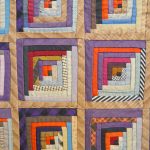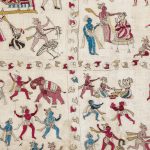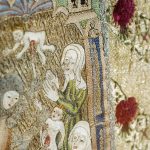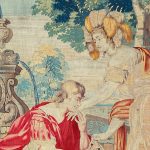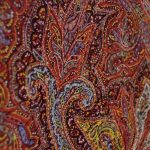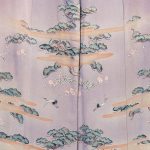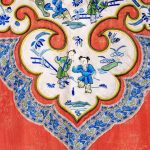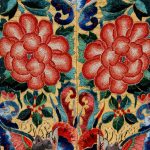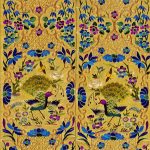This log cabin patchwork is believed to have been used as a ‘carriage rug’. Carriage rugs were made from thick, warm materials and were draped over the knees and legs whilst travelling in a carriage to help protect against chills and draughts. The many overlapping strips of fabric used to make log cabin patchwork create […]
View moreA partnership between Gawthorpe Textiles Collection and Dr Rohini Arora to give an in depth look at two rare and precious examples of embroidery from the Chamba region of India.
View moreThe Whalley Abbey Vestments are a set of exquisitely embroidered Medieval ecclesiastical garments with the full set comprising of a chasuble, two dalmatics and a maniple. Of these, the chasuble, maniple and one dalmatic are in the collection of Towneley Hall, while another matching dalmatic resides in the Burrell Collection in Glasgow. These vestments are […]
View moreA selection of jacquard designs and fabric samples produced by Birtwistle &Oddie Ltd of Prospect Mill, Wharf Street, Blackburn. The company was founded at Prospect Mill in 1907 by H. H. Birtwistle and A. M. Oddie. The company remained there until 1972 and was known for producing jacquard woven brocades, and later cotton and rayon […]
View moreThe four Tapestries situated in the Drawing Room of Astley Hall date from the mid-17th Century and depict the mythological story of Jason and his quest for the Golden Fleece. They were made in Flanders (Northern part of Belgium) and according to the records of the Victoria and Albert Museum there are only two other […]
View moreThis beautiful textile is an example of an amli shawl, a technique where small woven pieces are hand sewn together and then further embellished with embroidery. Every step of the making process was labour intensive and required high skill levels meaning that amli shawls were highly prized luxury items. Unlike many other styles of shawl […]
View moreJapanese hiki-furisode-style robe, of ombre dyed silk crepe with padded hem and long sleeves and lined with bright red silk. The robe has blank spaces for crests in the small circles either side of the front opening. The beautiful mauve ombre provides a backdrop for the delicate painted motifs depicting auspicious cranes along with pine […]
View moreLeek embroidery was a style of embroidery created and popularised by Sir Thomas and Lady Elizabeth Wardle through the Leek Embroidery Society. Thomas Wardle was an influential silk dyer with a particular interest in Indian silks and natural dyes that influenced his research and experimentation with dyeing processes and materials. He worked alongside several key […]
View moreThis Qing era robe has a typical straight cut, loose fitting body with square sleeves. The simple shape is designed to make efficient use of narrow widths of silk so that as little as possible of the expensive silk fabric is wasted when the garment is constructed. The main fabric is a lightweight silk with […]
View moreSleeve bands were decorative cuffs and would have decorated the bottom edges of the sleeves on a traditional robe. They often featured designs that were a near perfect mirror image of one another so that when the hands were clasped in front of the body and tucked slightly into the opposite sleeve, the designs would […]
View moreSleeve bands were decorative cuffs and would have decorated the bottom edges of the sleeves on a traditional robe. They often featured designs that were a near perfect mirror image of one another so that when the hands were clasped in front of the body and tucked slightly into the opposite sleeve, the designs would […]
View moreThis yellow brocaded silk was probably intended for use as garment fabric – perhaps as a woman’s gown or a man’s coat or waistcoat. The silk has a damask weave creating a self-coloured background pattern overlaid with vibrant, colourful floral sprays that have been added with additional brocade weaving. The brocade is further enhanced with […]
View more